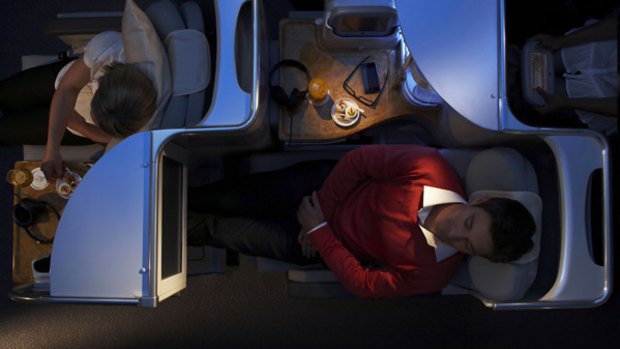
Emirates is extending its business-class benefits.
When you're doing a sardine impression in economy, it's only natural to ponder what flying is like for those "up the front". Everyone fantasises about stretching out in the comforts of business class but, for most, the leap in price – more than double in most cases – is too great.
Enter combination fares, which allow you to mix and match different classes of travel depending on your route and requirements.
You might choose to do the shorter leg of a long journey in economy class and upgrade to business for the longer leg you might choose business class for an overnight sector and economy for a daytime leg.
Combined with the huge growth of premium economy seating – a class between economy and business – combination fares are giving long-haul travellers more choices than ever.
Their arrival on the scene is almost certainly a product of the global financial crisis, which has driven airlines to think creatively like never before.
According to the International Air Transport Association, the economic downturn of 2008-2009 has had a greater impact on airlines than the terrorist attacks of September 11, 2001, which brought air travel to a near halt.
And while airlines always like to talk about travellers trading up from economy class rather than down from business class, there are certainly plenty of travellers who are trading down, with premium travel figures on a continuing slide.
For leisure travellers, these new fares represent an opportunity to try business class for the first time, or to have a more comfortable journey without the full price tag – and it seems Australians are embracing the fares with enthusiasm.
Emirates says combination fares to Europe generated “substantial demand” during a trial period, leading to them being extended until the end of March, a period including the busy Christmas season.
With Emirates, passengers fly business class on the long sector from Australia to Dubai, which takes about 17 hours, then economy from Dubai to Europe, which takes about five to seven hours.
Emirates is also extending business-class benefits, such as chauffeur-driven airport transfers and access to lounges, to passengers on combination fares.
Scandinavian Airlines, which offers flights from of Australia in partnership with airlines including Qantas and Thai, has taken the concept a step further by allowing passengers to mix and match among three classes: economy, business and premium economy.
In this case, passengers fly economy class (on a partner airline) on the shorter leg from Australia to Asia, then either premium economy or business on the longer leg to Europe.
Interestingly, an economy/business combination fare works out about the same as flying premium economy all the way, so you need to ask yourself what is important for you.
Premium economy is primarily about bigger seats and more legroom and often includes the same catering as economy class, although some airlines do include a better meal service.
Business class is a whole different ball game, with much better seats, meals, drinks, service and entertainment.
Complicating comparisons are top-tier airlines having introduced economy seats rivalling other airlines' premium economy offerings.
Then there are additional options, such as Jetstar's international Star Class, which is somewhere between premium economy and business class, with full catering and
in-flight entertainment but not the lie-flat seats that have come to dominate business-class fares.
The popularity of premium economy seats suggests many long-haul travellers really just want more space.
Airlines are investing heavily in this class, ripping out rows of economy seats or, in some cases, losing first or business-class seats to install more premium economy seating.
While it might seem we're heading towards a more luxurious means of travel, it is important to note that no-frills carriers are also continuing to grow, offering much cheaper fares at the expense of comforts and inclusions.
While many are prepared to pay a bit more for extra space or to arrive fresh after a good night's sleep, the majority of travellers will always want to get to their destination for the cheapest available price.
What price for better grades?
IT IS difficult for travellers to compare prices for different classes of travel; many factors influence the price of fares. However combination fares do represent good value for those seeking a more comfortable journey.
Economy/premium economy combination fares to Europe, for example, are available from about $3500 return, while economy/business combinations start at about $4300 return, depending on the airline. As a point of reference, you would normally expect to pay close to $2000 for economy, about $4000 for premium economy and about $7000 for business class.
You may need to approach a travel agent to help you find and compare the options as not all are available for online bookings and detailed knowledge of airlines' seating is vital in determining value.
Sign up for the Traveller newsletter
The latest travel news, tips and inspiration delivered to your inbox. Sign up now.